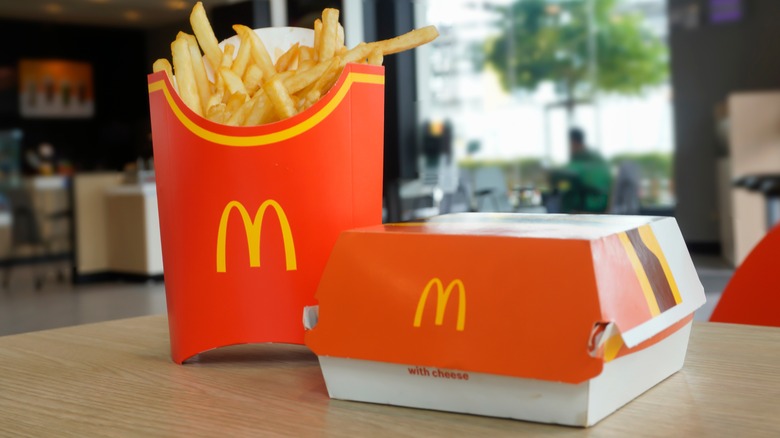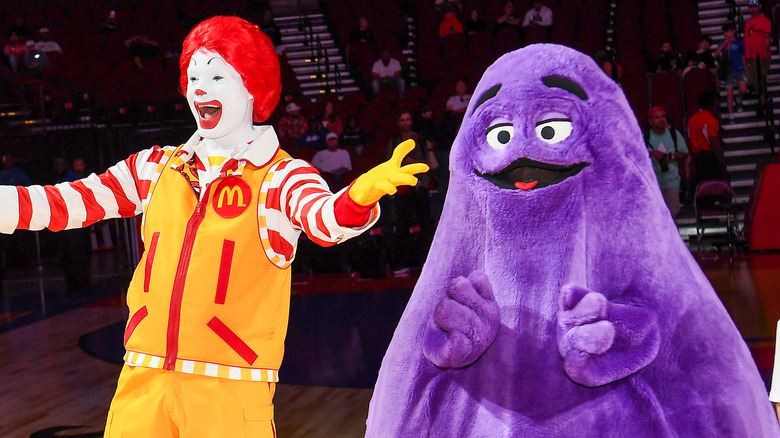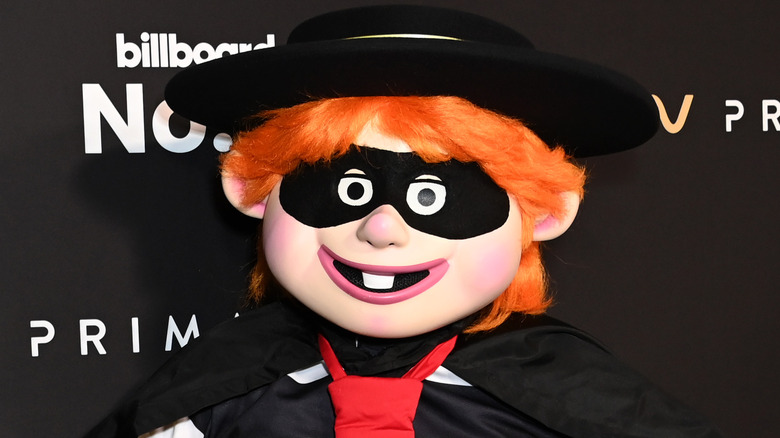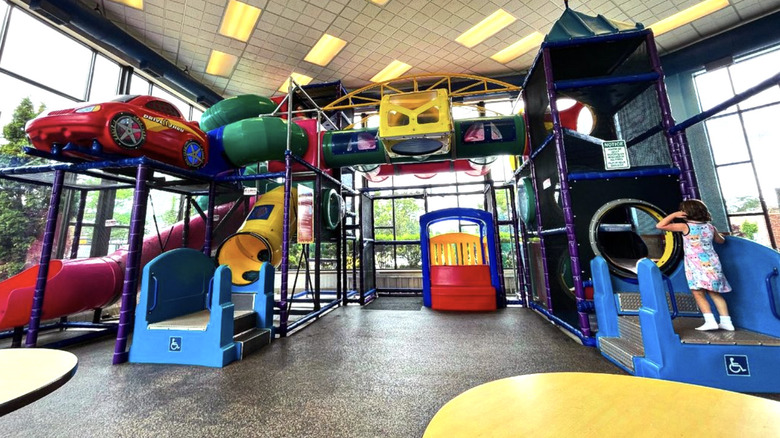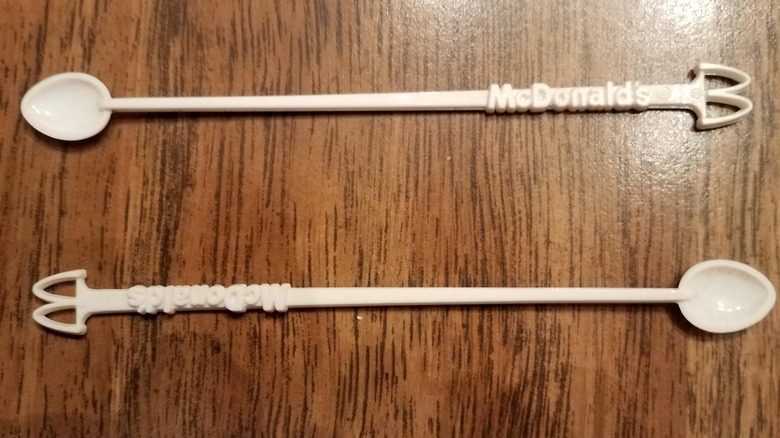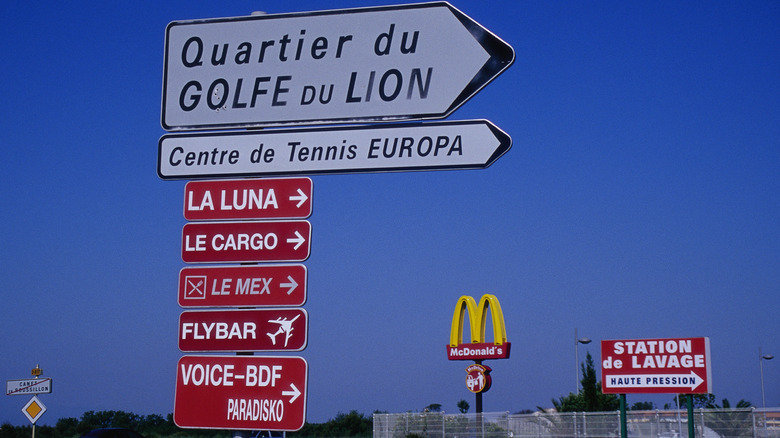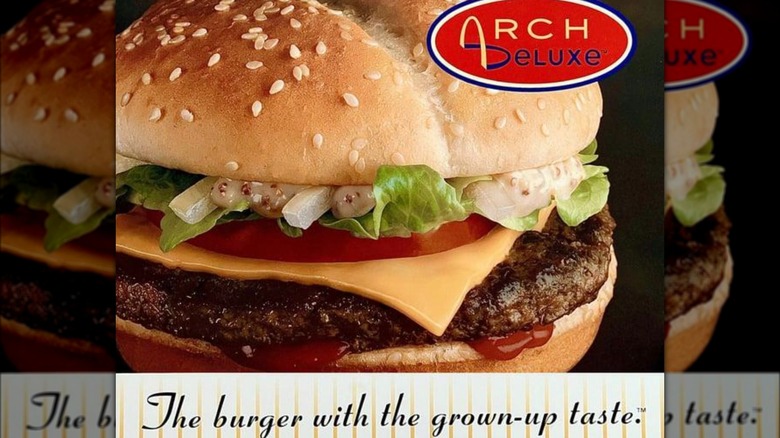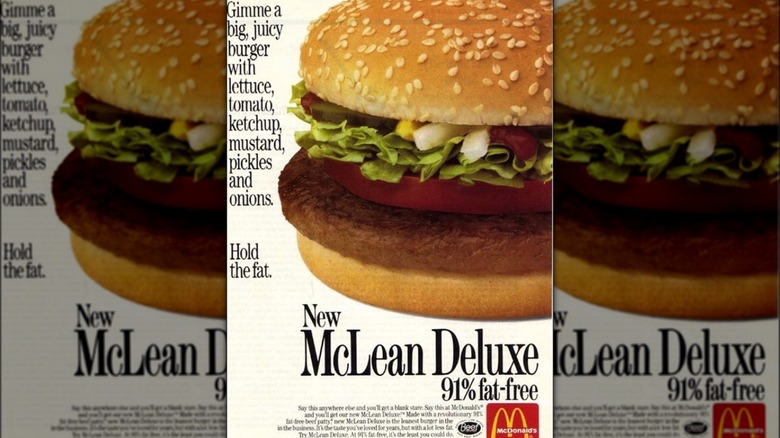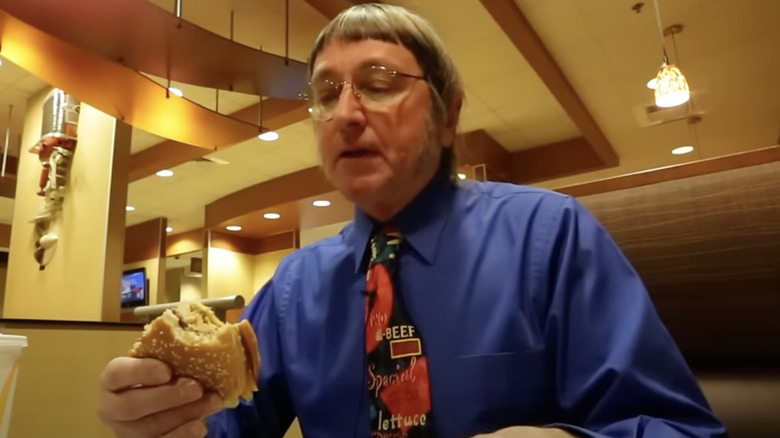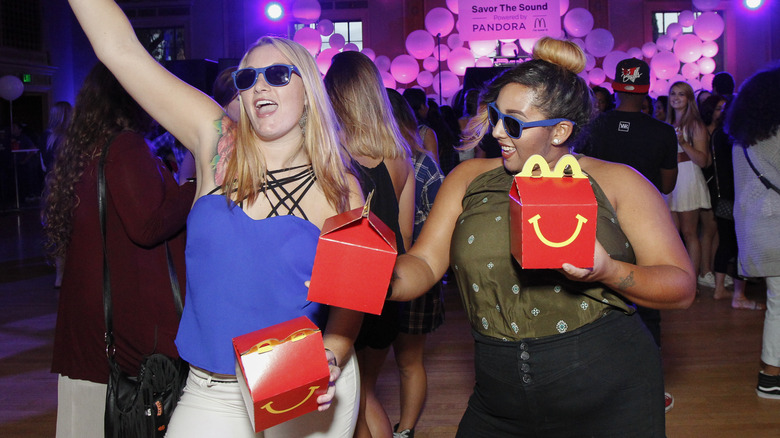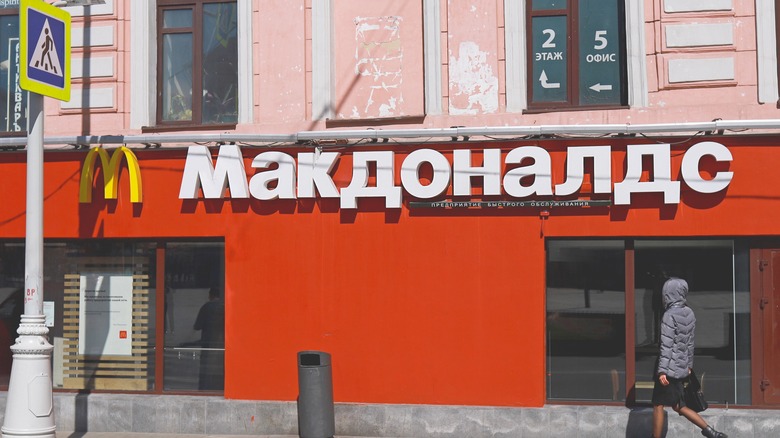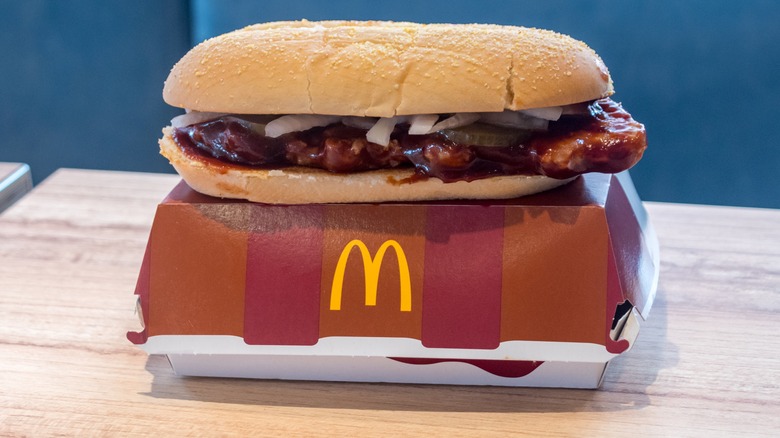Weird Things You Didn't Know About McDonald's
McDonald's seems like one of the most ordinary things in the world. There are tens of thousands of these "Golden Arches"-adorned fast food restaurants around the world, serving up cheaply priced burgers, fries, and McNuggets to its millions of regular customers who know exactly what to expect from the filling and comforting treats on offer. McDonald's is simply part of the cultural fabric, rarely a newsworthy topic or a generator of controversy — it's just a place where a Happy Meal or a value combo can quickly and easily reasonably please hungry people.
But McDonald's is a massive global operation. It employs thousands of people, earns billions in revenues every year, and has perpetuated the very concept of fast food to most corners of the globe. Doing all that, every day and all day (because they serve breakfast, too), requires a lot of resources and numerous moving parts. Consequently, not only are there a few shady secrets McDonald's doesn't want you to know but also mistakes happen, all of which invite scandal. Here are all the strangest and goofiest moments across the history of McDonald's.
McDonaldland was stolen from children's television
From 1971 until the early 2000s, the weird history of Ronald McDonald included the magical McDonaldland. The clown mascot had a bunch of friends and villains to interact with, most of them corresponding to and promoting a different McDonald's menu item. For example, Mayor McCheese and Officer Big Mac had hamburger-shaped heads, Birdie the Early Bird enjoyed McDonald's breakfasts, amorphous Grimace represented milkshakes, and Captain Crook stole Filet-O-Fishes.
In 1970, a representative of McDonald's advertising agency, Needham, Harper & Steers, floated an advertising campaign to Marty Krofft, who, along with his brother, Sid, produced a string of kids' television shows of the era. Until Saturday morning cartoons disappeared, they competed with programs like "H.R. Pufnstuf," "The Bugaloos," and "Sigmund and the Sea Monsters." After a few meetings, the agency told Marty Krofft that it had decided to scrap the campaign, and that it would no longer require the brothers' services. In 1971, the first McDonaldland ads debuted, produced with the help of some former Krofft show staffers. The Kroffts sued McDonald's, and Needham, Harper & Steers, alleging copyright infringement. Some of the examples named in the suit: Living Island from "H.R. Pufnstuf" resembled McDonaldland, and the title character clearly inspired Mayor McCheese, who similarly had a giant head and wore a sash declaring his authoritarian status. The Kroffts won the case, and McDonald's had to pay $1 million in damages and also retire the Mayor McCheese character.
It's been a long, strange journey for the Hamburglar
Among the original lineup of McDonaldland characters introduced in 1971 was a thieving bad guy referred to as the "Lone Jogger" — because that's the mysterious phrase printed on a T-shirt he wore. That name is a loose play on "Lone Ranger," and refers to how this character would run into parties and dinners and steal McDonald's hamburgers — this guy was also named the Hamburglar. Wearing a mask like the Lone Ranger and a big hat like Zorro, the Hamburglar also had untamed hair, a long nose, missing teeth, a cape, and a prisoner-like striped outfit. The character appeared in marketing materials in such a ghoulish fashion until 1985, when McDonald's ordered a redesign to make him less menacing and frightening to children, giving him red hair and a jolly, smiling face. The Hamburglar appeared in his last TV commercial in 2002, prior to a McDonald's maturity-centered rebrand in the early 2000s that limited the use of its old ad mascots.
In a nostalgia-driven, attempted viral marketing move in 2015, McDonald's revived and revised the Hamburglar. No longer played by a short actor in a suit and mask, the Hamburglar was now portrayed by a male model type sporting stubble and an elegant, Hamburglar-inspired costume. And he no longer cared for small cheeseburgers — he was brought back to promote the McDonald's Sirloin Third Pounder Burger.
It had to get rid of the PlayPlaces
The cast of McDonaldland characters didn't just appear in TV commercials for the fast food giant in the 1970s, '80s, and '90s. Those cartoonish creations were used to brand the playgrounds built on the property of thousands of McDonald's outlets. Formally called a PlayPlace, kids could burn off some of the energy acquired through the consumption of Harry Meals by romping around on fixtures such as the Hamburglar Swing and the Officer Big Mac Climb-in-Jail.
In the mid-1990s, McDonald's removed two pieces from every one of its PlayPlaces. In 1999, the public learned why the Tug-N-Turn and Big Mac Climber had quietly disappeared — they were demonstrably dangerous. The U.S. Consumer Safety Commission issued its most substantial punishment to that date, fining McDonald's $4 million. Over the course of the previous 20 years, more than 400 kids got injured while playing on the Big Mac Climber alone; McDonald's had never reported any of those casualties to the proper authorities. As dining out in general declined in the 2010s, the PlayPlaces were used less and less. When McDonald's spent $6 billion on a chain-wide remodeling operation, the playgrounds were almost entirely removed.
McDonald's banned stir sticks
A supply of small plastic spoons sat among the standard utensils and accessories on offer at most American McDonald's stores in the 1970s. A small spoon cup on one end with ornate McDonald's branding on the other, the tools were produced by the millions and made for stirring coffee and facilitating the addition of cream and sugar. But as the use of cocaine grew in the U.S. at the time, it would seem that the spoon held a serving of cocaine or PCP. Lifted continuously from McDonald's, drug users nicknamed the utensil the "McSpoon."
A 1979 newspaper story exposed the practice, describing a New York City party where the spoons were situated next to a large bowl of cocaine. Congress subsequently launched hearings into worries over the distribution and sale of drug paraphernalia; then-senator Joe Biden called out the "McSpoon" as an example, but since such an item wasn't intended for drug use, it would be tough to regulate its distribution. Joyce Nalepka, head of the National Federation of Parents for Drug Free Youth, approached McDonald's president Edward Schmidt and persuaded him to make a change. Soon after, McDonald's phased out the spoons in favor of plain stirrers.
McDonald's faced aggressive opposition in France
McDonald's operates the largest fast food chain on the planet, and it wields a lot of control wherever it expands. It's also a symbol of American-style capitalism, and those issues came into play during an organized anti-McDonald's rally that proved quite destructive. In 1999, the European Union prevented the import of American-raised beef because the hormone content violated that organization's standard of consumption safety. The U.S. responded by tacking on massive tariffs to European imports, including Roquefort cheese from France. To protest the U.S., five farmers targeted their outrage at a McDonald's in Millau that was in the process of being built. They led a group that tried to tear the building down, causing €120,000 worth of property damage while also holding a Roquefort tasting party. Protest leader José Bové went to prison for a few months and became a local hero for his anti-McDonald's and anti-globalization actions.
McDonald's moved beyond the event and grew a network of 1,500-plus restaurants in France. The distrust didn't completely disappear; "L'Express" reporter Emmanuel Paquette thought the chain's rapid rise seemed suspicious, and in 2014, he discovered that McDonald's had avoided paying French taxes through a shell corporation based in Luxembourg. In 2022, McDonald's agreed to a legal settlement over unpaid taxes from 2009 to 2020.
McDonald's tried to reach adults and alienate kids with the Arch Deluxe
After market research indicated that consumers classified McDonald's as a restaurant for children and adults with simplistic, pedestrian tastes in food, the company developed a new signature sandwich in 1996, designed to lure in an older, more urbane clientele. That new creation: the Arch Deluxe, an elevated (for fast food burger) made with a thick and heavily seasoned beef patty, sliced onions, a disc of bacon, cheese, lettuce, tomato, and a bespoke tangy sauce made primarily with mayonnaise and pepper.
Touting its "burger with the grown-up taste," McDonald's launched a $200 million advertising and marketing campaign to familiarize current, former, and never customers with the Arch Deluxe. A lot of that money was spent on print and TV commercials that really drove the point home of this being a sandwich for grown-ups only — the imagery consisted of children being physically repelled by the Arch Deluxe. McDonald's also tried to popularize the Arch Deluxe-promoting "Deluxe Line Dance," a "Macarena"-like easy to follow routine promoted with live events and a cutting edge for 1996 official website. By 1998, McDonald's realized it had overreached, and that it had tried to solve a problem that didn't really exist, and it started to phase out the Arch Deluxe. In 2000, it was taken off the menu altogether.
McDonald's almost sold a pineapple sandwich
Lent is the 40-day period preceding Easter. One way that Roman Catholics observe that period of reflection and self-sacrifice is by avoiding meat (but not fish) on Fridays. Lou Groen ran a franchised McDonald's in a significantly Catholic area of Cincinnati, and in 1962, he noticed with great concern how his restaurant's revenues plummeted each and every Friday during Lent. His business-salvaging idea: McDonald's should sell a sandwich that Catholics could eat on Fridays. Groen suggested to McDonald's head Ray Kroc a deep-fried whitefish patty served inside of a hamburger bun.
Kroc thought fish sandwiches would be too difficult to prepare in the average McDonald's kitchen, and he countered with his own meat-free sandwich concept: The Hula Burger. Pineapple, once one of history's strangest status symbols, was reduced to a burger filling, grilled and placed on a bun with a slice of American cheese. Kroc was so confident he'd come up with the next great fast food sensation that he test-marketed the Hula Burger and the Filet-O-Fish sandwich on a Lenten Friday at Groen's McDonald's in Cincinnati. He promised to put whichever sandwich sold the most onto McDonald's national menu. The total tally: 350 Filet-O-Fishes sold against a mere six Hula Burgers. In 1965, the Filet-O-Fish became the first new menu item after Ray Kroc paid a lot of money for McDonald's.
McDonald's failed to attract the low-fat crowd in the early '90s
In the late 1980s and early 1990s, a large number of Americans grew fascinated with what at the time was considered healthier eating, and food companies responded by offering reduced-fat and "lite" versions of their popular products. McDonald's got into the scene in 1991, with the McLean Deluxe. It looked like, and would theoretically taste like, its Quarter Pounder with Cheese, but with the cheese removed and lettuce, tomato, and other condiments added.
According to McDonald's, the McLean Deluxe was 91% fat-free, containing just 10 grams of fat, or roughly two-thirds less than what's in a Quarter Pounder with Cheese. To replace the calorically dense animal fat removed from the beef patty in processing, McDonald's food scientists added in a meat binder made from a mixture of water and seaweed. It tasted just different enough from a regular McDonald's burger, and it failed to attract many health-conscious diners. McDonald's got rid of the McLean Deluxe for good in early 1996.
There's a man with a Big Mac-based diet
There are people who enjoy the food at McDonald's, and then there's Don Gorske. He's such a fan of the fast food chain's famous and original creation, the three-bread, two-patty, special sauce-soaked tower known as the Big Mac, that he's consumed very little besides that particular hamburger for more than 50 years.
On May 17, 1972, the former prison official from Fond du Lac, Wisconsin, ate Big Mac no. 1. His first jaunt as a licensed driver was to the local McDonald's for a Big Mac. Gorske ate a total of nine Big Macs that day. That soon evolved into an unfailing daily habit of around two Big Macs, and in 1975, he proposed to the woman who became his wife at that same McDonald's. She doesn't care for cooking, so she's fine with her husband taking care of his own meals every day. "Being obsessive compulsive like I am, I just stayed in my same old routine all the time," Gorske told NBC 26. As of February 2024, the 70-year-old Gorske holds the Guinness World Record for the most Big Macs ever eaten. His total has now surpassed 34,000.
McDonald's held its own internal singing competition
Heavily-watched televised singing competition shows like "The X Factor" and "American Idol" took talent shows into the modern age. In 2005, McDonald's got in on the fun with its own company-wide musical competition, "Voice of McDonald's." Every employee from every part of the restaurant chain's worldwide operations was eligible to compete, and in peak years, at least 10,000 applications were received.
Set up like an elimination contest, with the collection of semi-finalists picked from regions around the world whittled down to a winner, McDonald's workers belted out popular songs in want of elaborate prize packages. In 2010, for example, Chenee Capuyan of a Davao Del Sur, Philippines, outlet, beat Jin Hur of Goyang City, South Korea, to be named the Voice of McDonald's by a voting panel that included R&B star Estelle, Mariah Carey's former creative partner Walter Afanasieff, and entertainment lawyer Ken Hertz. Capuyan won $25,000, a MacBook laptop, and two tickets to a Lady Gaga concert in Los Angeles.
McDonald's has been banned around the world
All told, there are more than 41,000 McDonald's restaurants operating around the world in at least 120 countries. Of the 75 or so other nations without access to Quarter Pounders and Happy Meals, the countries or McDonald's itself have declined to get a business arrangement going, while some governments have taken steps to prevent the American burger chain from ever operating within their borders. In the 1970s, Bermuda passed a law prohibiting non-locally-owned fast food restaurants, but McDonald's found a workaround by operating out of a U.S. Navy base. The station, and so too did the McDonald's, closed in 1995, and an attempt to open one to the general public in 1999 was heavily protested and ultimately prevented by authorities. A single, moveable McDonald's opened in Montenegro's capital of Podgorica in 2003, and it lasted for just three months before the government, acting on behalf of local businesses that didn't want the competition, stepped in to stop the chain from taking root.
When staunchly anti-American forces seized control of Iran in 1979, McDonald's was summarily banned. Instead, several clone restaurants called Mash Donalds soon opened for business throughout the country. After Russia invaded Ukraine in 2022, McDonald's pulled out of Russia, selling its restaurants there to a former franchisee. The popular chain quickly transformed into Tasty, selling bootleg approximations of familiar McDonald's menu items, such as a fake Big Mac called a "Grandee."
Without the McNugget, there would be no McRib
McDonald's first rolled out Chicken McNuggets to only some of its outlets in 1981. The bite-sized pieces of boneless, breaded-and-fried chicken were such a massive success in even a few markets that McDonald's knew it couldn't provide the entire chain with enough poultry to meet demand, and it didn't have a proper supply chain ready until 1983. In the meantime, McDonald's and its executive chef René Arend had to create another interesting, brand-new alternative to burgers to appease the franchisees that couldn't get McNuggets right away.
Inspired by pulled pork sandwiches from the South Carolina barbecue tradition, but needing a product easy to make in mass quantities, Arend developed a shaped and formed pork patty made almost entirely out of pork shoulder, and prepared to resemble a rack of ribs, with edible, darkened bumps replacing bones. Test marketed in the barbecue hub of Kansas City in 1981, the non-rib-based McRib hit more and more stores occasionally throughout the 1980s and beyond. More than 40 years later, McDonald's still only brings back the McRib for a few weeks at a time, having never added it to the permanent menu.
